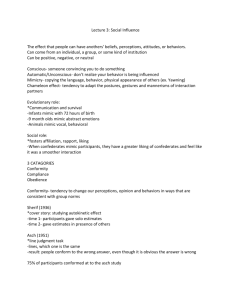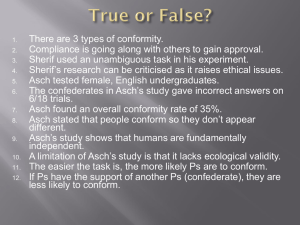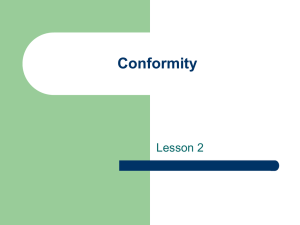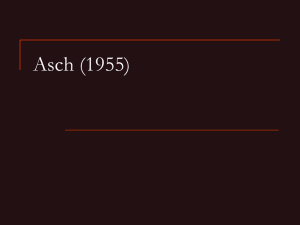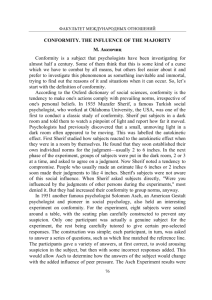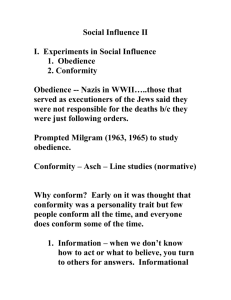Asch Worksheet (2013) NM
advertisement
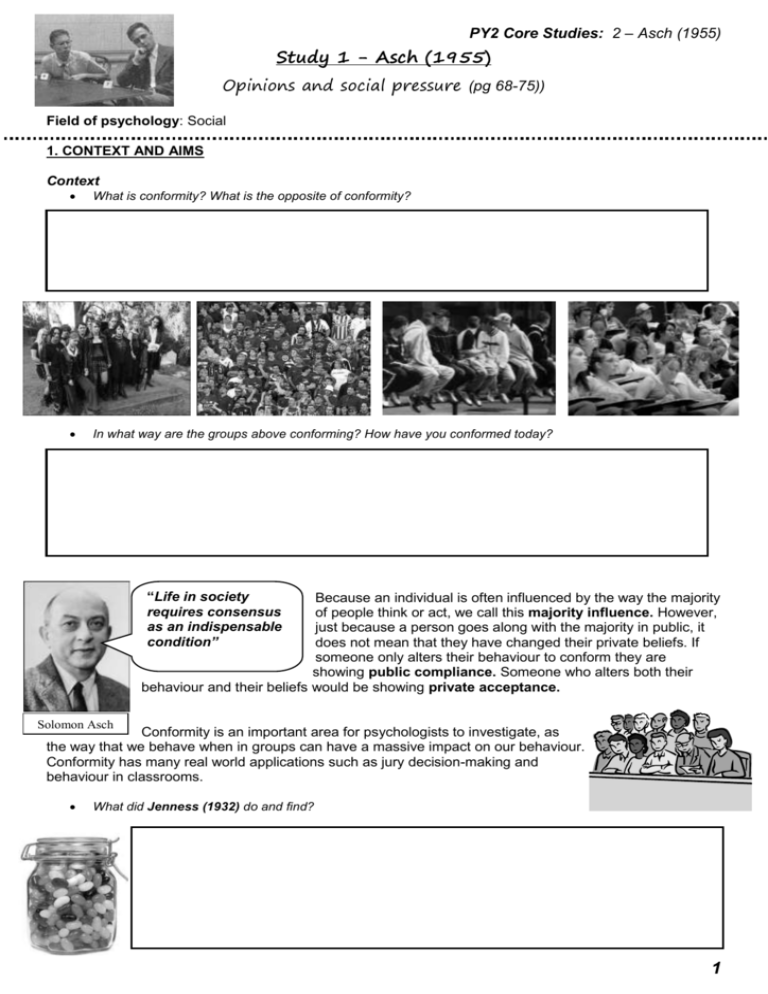
PY2 Core Studies: 2 – Asch (1955) Study 1 - Asch (1955) Opinions and social pressure (pg 68-75)) Field of psychology: Social 1. CONTEXT AND AIMS Context What is conformity? What is the opposite of conformity? In what way are the groups above conforming? How have you conformed today? “Life in society requires consensus as an indispensable condition” Because an individual is often influenced by the way the majority of people think or act, we call this majority influence. However, just because a person goes along with the majority in public, it does not mean that they have changed their private beliefs. If someone only alters their behaviour to conform they are showing public compliance. Someone who alters both their behaviour and their beliefs would be showing private acceptance. Solomon Asch Conformity is an important area for psychologists to investigate, as the way that we behave when in groups can have a massive impact on our behaviour. Conformity has many real world applications such as jury decision-making and behaviour in classrooms. What did Jenness (1932) do and find? 1 PY2 Core Studies: 2 – Asch (1955) An issue with Jenness’s study is that it is limited as the participants were specifically asked to produce a group estimate, rather than just observing whether they would produce similar estimate naturally without prompting.. However, these results suggest that in an ambiguous situation, we look to others to get a reasonable answer. How did Sherif (1935) use the autokinetic effect to investigate conformity? Sherif’s study is an improvement over Jenness’s as the participants were not specifically told to produce a group estimate. His participants arrived at a group norm under their own volition. An issue with the studies above is that they are both ambiguous situations, where there is no clear correct answer. It may be plausible that in these situations, conforming to a group norm is a sensible course of action. However, in 1955 there was little scientific evidence to suggest if and how people would conform in a situation where there was no ambiguity, and a clear correct answer. Asch also took issue with the methodology of these studies: “…confronted with opinions contrary to their own, many subjects apparently shifted their judgment in the direction of the views of the majorities ... there is some reason to wonder whether it was not the investigators who, in their enthusiasm for a theory, were suggestible, and whether gullible subjects were providing answers they thought good subjects were expected to give.” Think back to your work on research methods. What terms can we use to sum up Asch’s criticisms? _____________________________________________________________________________________ _____________________________________________________________________________________ ________________________________ Asch also gave two further reasons for the importance of studying conformity. Read the information on page , and complete below 2 PY2 Core Studies: 2 – Asch (1955) Aims What was Asch’s main aim? He also aimed to investigate the effect of various factors on the rate of conformity. Read the information at the top of page 69 , and group them below, predicting whether the rate of conformity will be higher, or lower Higher conformity Lower Conformity Summary Context Definition of conformity Jenness (1932) Sherif (1935) Technology allowing mass social influence Conformity in Nazi Germany Aims To investigate whether participant would conform to an unambiguous situation To investigate if conformity would be influenced by various factors. 3 PY2 Core Studies: 2 – Asch (1955) 2. PROCEDURES Asch carried out a number of variations of the same experiment. You need to know in-depth procedures for the baseline study, and also some of the variations. Use the textbook page 69. BASELINE STUDY Number and make-up of participants Research method used Experimental design Independent variable Dependant variable Outline the procedure The participants were asked to take part in a “vision experiment”. However, the real aim of the study was to investigate conformity. In each trial, there was one naïve participant and six to eight confederates (or stooges). These were people who knew the aims of the study and acted in the way that the experimenters told them. The group are shown two large white cards. One has a single line on it, which is to be matched in length to one of three lines of different length on the other card (see below). The group of participants verbally reports their visual judgments in order. This task is repeated 18 times. The last but one participant in each group is the ‘naïve’ participant. The confederates have been told to give the same obviously wrong answer on 12 of the 18 trials. These 12 trials are called critical trials. The participants could react on one of two ways. They could either verbally report the same answer as the rest of the participants (an obviously wrong answer) i.e. conform, or they could report a different answer to the rest of the participants (the correct answer), i.e. not conform. After the experiment, the participants were debriefed and told the true aim of the study and interviewed about their responses and behaviour. Naive participant 4 PY2 Core Studies: 2 – Asch (1955) Think about the procedure above, and answer the following two questions. Wherever you can, try to use correct research methods terminology: Q1: Why was the naïve participant always second from last? Q2: Why did the confederates not give a wrong answer on every trial? VARIATIONS ON THE BASELINE PROCEDURE Outline the procedures for the following variations (you only need to describe how this procedure is different from the baseline, you don’t need to go into as much detail) The size of the majority A truthful partner An inaccurate partner A partner who changes his mind A partner who leaves 5 PY2 Core Studies: 2 – Asch (1955) Asch also investigated the effect of gradual majority influence. In this procedure, the confederates all began by giving the correct answer, but then one by one began giving wrong answers, until eventually the participants was alone and the group unanimously against him. He also investigated the effect on the degree of wrongness of the majority. He varied the discrepancy between the standard line and the other lines, with the aim of reaching a point where the error was so glaringly obvious, that no-one would every subject would be compelled to give the right answer. 3. FINDINGS AND CONCLUSIONS Similarly to the procedures, you need to know the findings and conclusions from the baseline study, and also from some of the variations. Findings In a control study carried out before this experiment, it was found that less than 1% of people made errors when carrying out this task when by themselves. What does this suggest about the line estimating task? ____________________________________________________________________________________. The baseline study Asch found that participants gave wrong answers 36.8% of the time. This means that of all the critical trials, 36.8% of responses were wrong (however, it also means that 63.2% of responses were right). However, there was a considerable amount of difference between individuals with regards to how much they conformed. 25% of participants never gave a wrong answer once i.e. they did not conform. (Conversely, this means that 75% of participants conformed at least once.) At the other extreme, some participants agreed with the majority on nearly every critical trial. Regardless of whether the participant conformed or did not conform, their behaviour was constant. Those who didn’t agree with the majority, tended not to agree with them consistently. Asch states “Those who strike out on the path to independence, do not, as a rule, succumb to the majority”. Interviews with the participants after the experiment showed that independent individuals o had “staunch confidence in their own judgment” o had the “capacity to recover from doubt and to re-establish their equilibrium” o felt it was “their obligation to call the play as they saw it” Graph showing the number of correct answers when alone (top line) and when with the confederates (bottom line) Those who did agree with the majority, tended to agree consistently. As Asch says “Those who chose the path of compliance are unable to free themselves, and the ordeal is prolonged”. Compliant (conforming) individuals o believed that “I am wrong, they are right” o conformed so as “not to spoil the results" o suspected the majority were “sheep” following the first responding participant o thought the majority were “victim of an optical illusion” o thought they were ‘deficient’ in comparison to the rest of the group, and this deficiency’ needed to be hidden at all costs Compliant individuals also tended to under estimate the frequency with which they conformed. 6 PY2 Core Studies: 2 – Asch (1955) Variations on the baseline study The size of the majority A truthful partner An inaccurate partner A partner who changes his mind A partner who leaves Gradual Majority Influence Asch found that as long as the participant had at least one other person on his side, he was nearly always independent and gave the correct answer. However, as soon as he found himself alone, the tendency to conform to the majority rose abruptly. Degree of wrongness Surprisingly, even when the difference between the correct answer and wrong answer was 7 inches (and so there is no doubt what the correct answer is), some participants still conformed and went with the majority in giving the wrong answer! Conclusions What is the main conclusion from all of the findings above? (Baseline and variations) 7 PY2 Core Studies: 2 – Asch (1955) What can be concluded about the effect of the size of the majority and the effect of a dissenter? “That we have found the tendency to conformity in our society so strong that reasonably intelligent and well meaning young people are willing to call white black is a matter of concern… Yet anyone inclined to draw too pessimistic conclusions from this report would do well to remind himself that the capacities for independence are not to be underestimated…those who participated in this challenging experiment agreed However: nearly without exception that independence was preferable to conformity”. What can this study tell us about resisting conformity? 4. EVALUATING THE METHODOLOGY Method: This study took place in a laboratory. The advantages of this are:___________________________ _____________________________________________________________________________________ _____________________________________________________________________________________ _____________________________________________________________________________________ _____________________________________________________________________________________ ________________________________________________________________ However: _____________________________________________________________________________________ ______ _____________________________________________________________________________________ _____________________________________________________________________________________ _____________________________________________________________________________________ ________________________________________________ Reliability: Larsen (1974) replicated Asch’s experiment and found that the conformity levels were a lot lower than what Asch found. Similarly, Perrin and Spencer (1980) conducted a similar experiment and found that out of 396 trials, only one participant conformed. What does this suggest about the reliability of this experiment? ________________________________________________________________________ 8 PY2 Core Studies: 2 – Asch (1955) _____________________________________________________________________________________ _____________________________________________________________________________________ _____________________________________________________________________________________ ________________________________________________ Validity: One of Asch’s criticisms of Sherif and Jenness was that the participants in those studies may have been led to act a certain way by the experimenter through investigator effects. Could the same criticism be made of Asch’s study? ___________________________________________________________ _____________________________________________________________________________________ _____________________________________________________________________________________ _____________________________________________________________________________________ ________________________________________________ Was the line comparison task a valid test of conformity? Would different results have been gained if the participants had been given a different task? __________________________________________________ _____________________________________________________________________________________ _____________________________________________________________________________________ _____________________________________________________________________________________ ________________________________________________ How ecologically valid was this study? ______________________________________________________________ _____________________________________________________________________________________ _____________________________________________________________________________________ _____________________________________________________________________________________ ________________________________________________ The participants had to say their answer out loud in front of strangers? Could this have affected the levels of conformity? _______________________________________________________________________________ _____________________________________________________________________________________ _____________________________________________________________________________________ _____________________________________________________________________________________ ________________________________________________ Sampling: The sampling method used was “volunteer/self selected”. What issues could this raise for this study? _____________________________________________________________________________________ _____ _____________________________________________________________________________________ _____________________________________________________________________________________ _____________________________________________________________________________________ ________________________________________________ Was the sample biased? __________________________________________________________________________ _____________________________________________________________________________________ _____________________________________________________________________________________ _____________________________________________________________________________________ ________________________________________________ 9 PY2 Core Studies: 2 – Asch (1955) Ethical issues: Were there any ethical issues raised by this study? ___________________________________ _____________________________________________________________________________________ _____________________________________________________________________________________ _____________________________________________________________________________________ _____________________________________________________________________________________ _____________________________________________________________________________________ _____________________________________________________________________________________ _____________________________________________________________________________________ _____________________________________________________________________________________ _____________________________________________________________________________________ ___________________________________________ 5. CRITICALLY ASSESS WITH REFERENCE TO ALTERNATIVE EVIDENCE Look back at the studies by Sherif and Jenness. Do these findings support, contradict, or develop Asch’s results? As mentioned above, both Perrin and Spencer (1980) repeated Asch’s experiment, but found a much lower level of conformity (1 person conformed out of 396 trials). A number of explanations have been developed to explain why Asch found such a high level of conformity in his study. It has been argued by some that Asch’s study was a child of it’s time. 1950s America was a highly conformist society, with the anticommunist McCarthyism fostering an environment which was distrustful of outsiders. However, it has also been argued that Asch’s study is more realistic and valid, as the study by Perrin and Spencer used science students as its participants. It may be that they may have felt more confident about their ability to measure lines, and so conformed less. Modern research however seems to support Asch’s findings. Read the information on page 72-3. What did Nicholson et al (1985) find? 10 PY2 Core Studies: 2 – Asch (1955) All of the participants used in Asch’s study were men. However, there is evidence that there are differences in the way men and women conform to social influence. Eagly (1978) performed a meta-analysis, analysing the results from many studies into conformity. She found that women are more conforming than men in group pressure situations. Can you think of a reason why this would be the case? Asch’s study only used participants from the USA. What did Smith and Bond (1988) do, what did they find, and what does this suggest about Asch’s original study? (pg 73) Use three colours to highlight research that supports, contradicts, or develops Asch’s research (some may be more than one colour). 11
